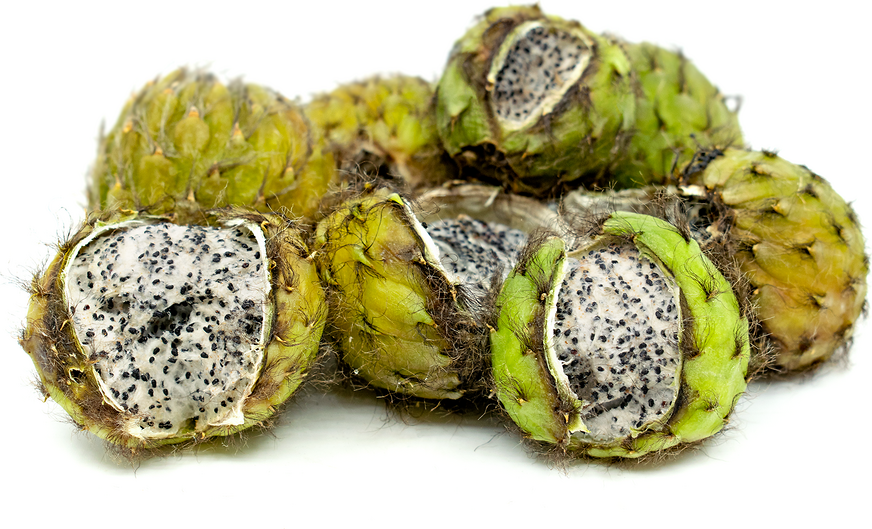


Golden Torch Cactus Fruit
Estimated Inventory, bskt : 0
Description/Taste
Golden Torch cactus fruits grow on tall, upright, straight, and slender stems, reaching as high as two meters in height. Each stem averages 5 to 6 centimeters in diameter and has a narrow appearance, showcasing variegated hues of green and yellow. The stems are also deeply ribbed, developing 10 to 15 vertical channels that extend the length of the cactus, and over time, the stems develop upright branches that grow from the base. The cacti’s surface is generally smooth, covered in straight, sharp spines that range in color from red, amber, to yellow, eventually fading to white as they age. In the late spring and sometimes in the fall, the cactus will produce large white blooms that can open to 12 to 20 centimeters in diameter. If the showy flowers are pollinated, they develop small, round to oval fruits approximately 5 to 6 centimeters in length and 3 to 4 centimeters in diameter. Each fruit is covered in a protective green husk enveloped in soft, black-brown hair-like spines. When the fruits are ripe, this casing will split open to reveal a cotton-like flesh containing many tiny and shiny black seeds. Only the white flesh and seeds are consumed, discarding the green husk, and the flesh has a soft, spongy, and grainy mouthfeel. Some consumers note that it sometimes has the texture of cotton candy intermixed with chewy seeds. Golden Torch cactus fruits have a sweet, neutral flavor with subtle rose, kiwi, and strawberry nuances.
Seasons/Availability
Golden Torch cactus fruits are periodically available year-round, depending on the climate, and have peak seasons in the late spring and fall.
Current Facts
Golden Torch cactus fruits, botanically classified as Echinopsis spachiana, are rare, seasonal fruits belonging to the Cactaceae family. The small, ball-like fruits grow on the sides of the upright cactus stems and appear after the variety’s large white flowers bloom and have been pollinated. Golden Torch cactus fruits are foraged items and are not commercially cultivated. It is important to note that the ripest fruits often split open while still on the cactus. This split is a signal to foragers that the fruits are ready for harvest, and it is not a sign of old age. Golden Torch cactus fruits are challenging to find in local markets and are considered a specialty ingredient used by select chefs and home cooks.
Nutritional Value
Golden Torch cactus fruits have not been studied for their nutritional properties. Like other cactus fruits, the variety may be a small source of fiber to regulate the digestive tract. Cactus fruits have also been known to contain low levels of vitamin C to strengthen the immune system while reducing inflammation, antioxidants to protect the cells from the damage caused by free radicals, and provide other nutrients, including potassium, calcium, and magnesium.
Applications
Golden Torch cactus fruits are a niche foraged ingredient not commonly utilized in culinary preparations. The fruits are traditionally consumed straight out of hand, and the protective green husk should be removed, only consuming the cottony white flesh and shiny black seeds. Among foragers, it has been said that the driest looking part of the flesh tends to be the sweetest. Look for fruits that have a drier texture rather than appearing glossy or wet. Golden Torch cactus fruits can be eaten as a standalone snack, or they can be tossed into salads, mixed into fruit bowls, diced into fruit salsas, or stirred into breakfast dishes such as yogurt. The soft texture of the fruit also lends itself well to pureeing or blending into smoothies, and some chefs can transform it with other ingredients into a sorbet. Try using Golden Torch cactus fruit as a decorative topping over desserts such as cakes, tarts, or ice cream. Golden Torch cactus fruit has a bland but sweet flavor, pairing well with strawberries, pineapple, bananas, mangoes, vanilla, almond extract, and honey. Once harvested, the fruits should be immediately consumed for the best quality and flavor.
Ethnic/Cultural Info
Golden Torch cacti received their name from their amber to yellow-colored spines. When the sun shines on the cactus at an angle, the golden spines can have a glowing, backlit appearance, creating a warm-toned illusion. As the plant matures, the spines transform into a silvery gray hue and become almost reflective in the desert sunlight. Golden Torch cacti are primarily grown as a decorative landscape plant in home gardens. The variety is prevalent throughout the American Southwest, Mexico, and Australia and is a type of columnar cacti, continually growing in an upright formation. The variety is also one of the slowest growing types of columnar cacti available for cultivation. This trait allows smaller specimens to be planted in containers used in home gardens for their architectural and elongated appearance.
Geography/History
The Golden Torch cactus is native to Bolivia and Western Argentina and has been growing wild in South America since ancient times. In Argentina, the cactus is mainly found in the San Juan, Neuquen, Mendoza, Jujuy, Salta, Tucuman, La Rioja, and Catamarca regions. The variety thrives in well-drained, loamy soil and prefers warm to hot, dry conditions. Over time, Golden Torch cacti were spread across South America and were introduced to the United States, Mexico, and Australia. The variety was also brought to South Africa, where it eventually naturalized, but many indigenous South African communities consider it a weed. Today Golden Torch cacti are still found growing wild in South America and are sold as a home garden landscape plant in warm climates worldwide. The fruits are not commercially grown and are foraged from available cacti, leading the fruits to be sporadically available through local markets and specialty distributors.




